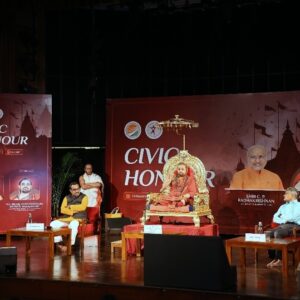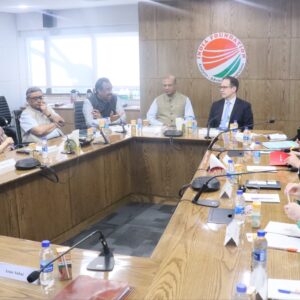Has Bharat changed in the last ten years? Many would view the question as rhetorical, as Bharat has not only changed in a myriad of ways over the last decade, but the extent of change has been colossal. Let us examine the changes that have taken place in a few select sectors.
Over the last decade, Bharat’s economy has seen tremendous growth, despite the COVID-19 pandemic, which adversely impacted Bharat and the world during the two-year period from 2019 to 2021. According to the World GDP Ranking 2024 list, Bharat, with a GDP of USD 4.1 trillion, is now the fifth largest economy in the world, up from the tenth position in 2014, where Bharat’s GDP stood at USD 2.04 trillion. The inflation rate was also kept in check for the 2014-2024 decade, with inflation below 5 percent for most of the period. This stood in sharp contrast to the inflation levels during the 2004-2014 period, where inflation hovered for the most part near the 10 percent level. The per capita income also saw a significant rise from USD 1560 in 2014 to USD 2847 in 2024, an increase of 82.5 percent. This, in conjunction with low inflation rates, has substantially raised the standard of living of a vast segment of the population.
Defence preparedness is yet another success story. While Bharat is still heavily dependent on imports for a variety of upper-end defence equipment and is at present the largest arms importer in the world, concerted efforts have been made over the last decade to increase indigenous defence production and reduce dependence on imports through initiatives like the “Make in India” campaign and reforms in defence procurement policies. There is also a renewed focus on defence exports, which have touched USD 2.63 billion in the financial year 2023-2024. This represents a 32 percent increase over the previous year and is set to further increase in the coming years. The private sector is also contributing to Bharat’s growth story in the defence sector, and in conjunction with the Defence Public Sector Undertakings (DPSUs), is playing a crucial role in modernising and strengthening India’s defence capabilities. The last decade has also seen increased focus on the creation of defence infrastructure on India’s Northern and Eastern borders, with a large number of projects being completed by the Border Roads Organisation (BRO). Among these are the Sela Tunnel, constructed at an altitude of 13,000 feet; the Darbuk-Shyok-DBO Road, an all-weather strategic road in eastern Ladakh right up to the border; and the construction of the Zojila Tunnel at an altitude of 11,500 feet, which is part of the broader effort to improve connectivity to the border and correct the infrastructure imbalance with China.
Bharat’s foreign policy has also become more assertive, with a heightened focus on the country’s national interest, as seen by its stance on the Ukraine war, the Hamas-Israeli conflict, and its engagement in strategic partnerships with various countries, including the United States, Japan, Australia, and ASEAN. These partnerships are aimed at enhancing Bharat’s strategic and economic interests and promoting stability in the region. This assertiveness is also seen in Bharat’s response to cross-border terrorism emanating from Pakistan and also to Chinese aggressive behaviour in Eastern Ladakh and along the McMahon Line. A feature of Bharat’s nuanced change in its foreign policy is the role it seeks for itself on the global stage. This includes seeking membership in international forums such as the United Nations Security Council and actively participating in global initiatives on climate change, peacekeeping, and other issues. Another visible change in foreign policy is Bharat’s engagement with its diaspora, which it views as a strategic asset, contributing to economic growth, cultural exchange, and fostering closer ties with countries around the world. This has contributed greatly to India’s soft power and enhanced its image in the world, where Bharat is increasingly being viewed as the voice of the Global South.
Significant progress in the last decade has also been made in reforming the education sector, imparting skills to the population, digitalisation, focusing on upper-end technology, food and energy security, and also in many other fields. But perhaps the most profound change that has occurred is a mindset change that has imbued a new-found confidence and spirit among all sections and strata of society. This self-view of increasingly large segments of the population, as well as of their role in society and in nation-building, is reflected in a burgeoning start-up ecosystem, fuelled by a growing entrepreneurial spirit, supportive government policies, and increased venture capital investment. Young Bharatiyas are increasingly willing to take risks, innovate, and pursue their entrepreneurial dreams. There is a growing realisation, especially among the youth, that while the role of the government as a facilitator is essential for their economic progress and well being, it is their effort and struggle that will ultimately bear fruit. There is also an attitudinal change, where the people of Bharat are becoming increasingly conscious of their culture and heritage and are now proudly attached to their roots. Perhaps this is the reason why the construction of the Ram Temple at Ayodhya was so eagerly awaited, and why its inauguration satisfied a long-felt yearning and need. It was indeed a moment of spiritual awakening for the nation.
Bharat is today on the march, walking confidently on its unstoppable path to progress. This is perhaps the greatest achievement of the decade under the Prime Ministership of Shri Narendra Modi.
Author Brief Bio: Maj. Gen. Dhruv C. Katoch is Editor, India Foundation Journal and Director, India Foundation.




